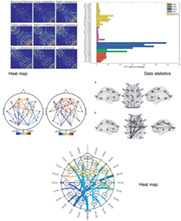- Record: found
- Abstract: found
- Article: found
Brain functional and effective connectivity based on electroencephalography recordings: A review

Read this article at
Abstract
Functional connectivity and effective connectivity of the human brain, representing statistical dependence and directed information flow between cortical regions, significantly contribute to the study of the intrinsic brain network and its functional mechanism. Many recent studies on electroencephalography (EEG) have been focusing on modeling and estimating brain connectivity due to increasing evidence that it can help better understand various brain neurological conditions. However, there is a lack of a comprehensive updated review on studies of EEG‐based brain connectivity, particularly on visualization options and associated machine learning applications, aiming to translate those techniques into useful clinical tools. This article reviews EEG‐based functional and effective connectivity studies undertaken over the last few years, in terms of estimation, visualization, and applications associated with machine learning classifiers. Methods are explored and discussed from various dimensions, such as either linear or nonlinear, parametric or nonparametric, time‐based, and frequency‐based or time‐frequency‐based. Then it is followed by a novel review of brain connectivity visualization methods, grouped by Heat Map, data statistics, and Head Map, aiming to explore the variation of connectivity across different brain regions. Finally, the current challenges of related research and a roadmap for future related research are presented.
Abstract
This article reviews EEG‐based functional and effective connectivity studies undertaken over the last few years, in terms of estimation, visualization, and applications associated with machine learning classifiers. Methods are explored and discussed from various dimensions, such as either linear or nonlinear, parametric, or nonparametric, time‐based, frequency‐based or time‐frequency‐based. Then it is followed by a novel review of brain connectivity visualization methods, grouped by Heat Map, data statistics and Head Map, aiming to explore the variation of connectivity across different brain regions. Finally, the current challenges of related research and a roadmap for future related research are presented.
Related collections
Most cited references153

- Record: found
- Abstract: found
- Article: found
The Human Brainnetome Atlas: A New Brain Atlas Based on Connectional Architecture
- Record: found
- Abstract: found
- Article: not found
Functional connectome fingerprinting: Identifying individuals based on patterns of brain connectivity
- Record: found
- Abstract: found
- Article: not found
